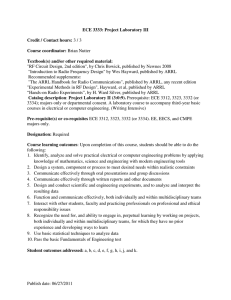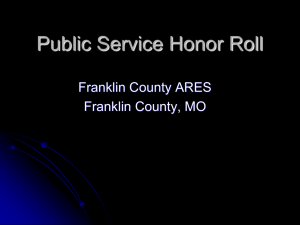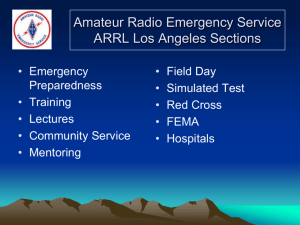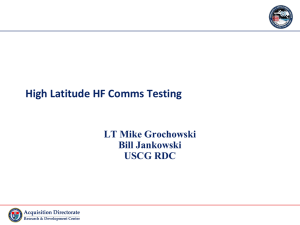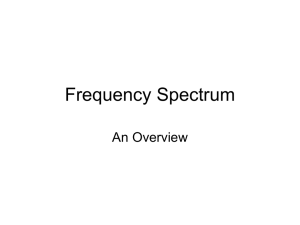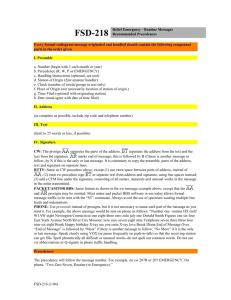May 2002 doc.: IEEE 802.18-02/002r0
advertisement
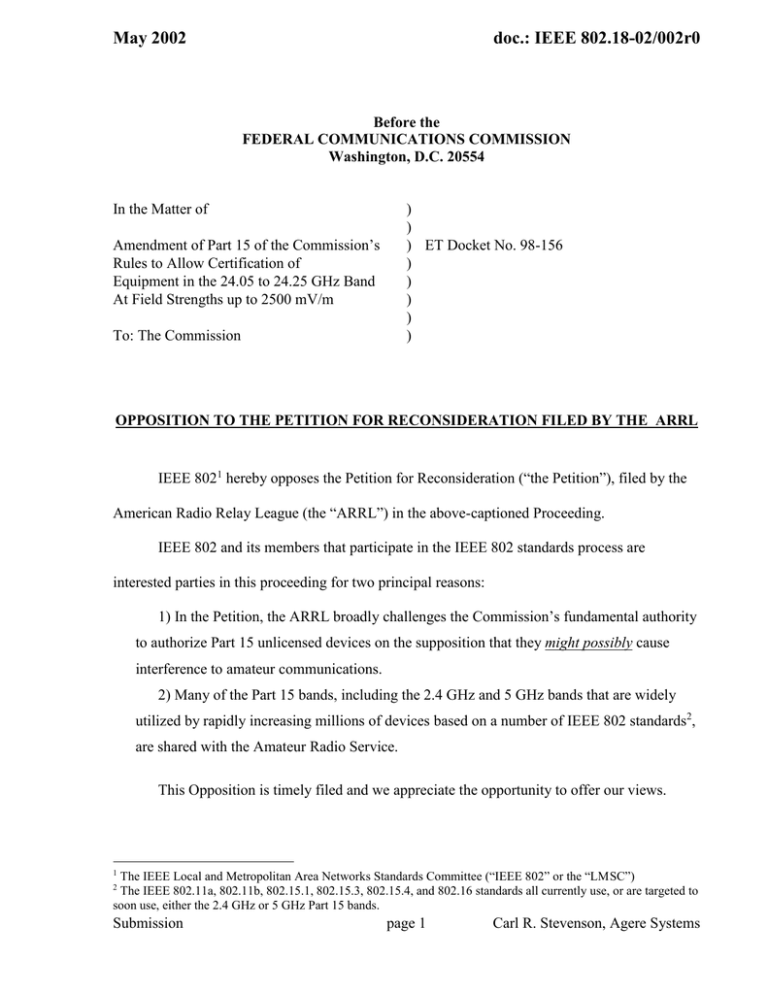
May 2002 doc.: IEEE 802.18-02/002r0 Before the FEDERAL COMMUNICATIONS COMMISSION Washington, D.C. 20554 In the Matter of ) ) ) ET Docket No. 98-156 ) ) ) ) ) Amendment of Part 15 of the Commission’s Rules to Allow Certification of Equipment in the 24.05 to 24.25 GHz Band At Field Strengths up to 2500 mV/m To: The Commission OPPOSITION TO THE PETITION FOR RECONSIDERATION FILED BY THE ARRL IEEE 8021 hereby opposes the Petition for Reconsideration (“the Petition”), filed by the American Radio Relay League (the “ARRL”) in the above-captioned Proceeding. IEEE 802 and its members that participate in the IEEE 802 standards process are interested parties in this proceeding for two principal reasons: 1) In the Petition, the ARRL broadly challenges the Commission’s fundamental authority to authorize Part 15 unlicensed devices on the supposition that they might possibly cause interference to amateur communications. 2) Many of the Part 15 bands, including the 2.4 GHz and 5 GHz bands that are widely utilized by rapidly increasing millions of devices based on a number of IEEE 802 standards2, are shared with the Amateur Radio Service. This Opposition is timely filed and we appreciate the opportunity to offer our views. The IEEE Local and Metropolitan Area Networks Standards Committee (“IEEE 802” or the “LMSC”) The IEEE 802.11a, 802.11b, 802.15.1, 802.15.3, 802.15.4, and 802.16 standards all currently use, or are targeted to soon use, either the 2.4 GHz or 5 GHz Part 15 bands. 1 2 Submission page 1 Carl R. Stevenson, Agere Systems May 2002 doc.: IEEE 802.18-02/002r0 IF GRANTED, THE ARRL’S PETITION WOULD CAUSE IRREPARABLE HARM TO THE PUBLIC INTEREST The ARRL, by its challenge, in the Petition, to the Commission’s authority to 1. authorize Part 15 devices on the preemptive basis that they might possibly cause interference, seeks to upset a regulatory regime that has served the public interest well for over six decades. The history of innovation spawned by the Commission’s Part 15 rules has been 2. nothing short of a spectacular success story and the Commission is to be applauded for its wisdom and foresight in creating such an environment where technology and innovation can flourish, relatively unfettered by unnecessarily restrictive regulations. The Commission’s Part 15 rules have spawned an entire industry that has created 3. many tens of thousands of high technology jobs, added billions of dollars to the GNP, and brought the benefits of a wide variety of convenient, economical communications devices to a business, industry, education, health care providers, and consumers alike. To “pull the rug out from under” Part 15, as the ARRL would do, would devastate 4. the industry and do great harm to the users of the technologies that Part 15 has enabled. THE COMMISSION’S BASIS FOR PART 15 IS LEGALLY SOUND 5. Despite the ARRL’s assertions to the contrary, the Commission’s Part 15 rules are solidly grounded in the provisions of the Communications Act, as amended, (the “Communications Act”) and the Commission has not overstepped its Congressionally-granted authority. 6. The Commission has, as indicated (at 1) above, authorized unlicensed operation of intentional, unintentional, and incidental radiators of radio frequency energy for well over sixty years. Submission page 2 Carl R. Stevenson, Agere Systems May 2002 7. doc.: IEEE 802.18-02/002r0 The Commission’s Part 15 rules3 clearly outline the conditions under which the Commission permits the use of such devices without individual licenses. Other parts of the Commission’s rules, such as portions of Part 954, also authorize the use of the radio frequency spectrum by rule without the necessity of users obtaining individual licenses. 8. The fundamental provisions of the Commission’s Part 15 rules are entirely consistent with Section 301 of the Communications Act. Congress, by not specifying any procedural requirements for making licensing determinations, inherently granted the Commission broad discretion to use its sound judgment in making such determinations. The Commission has wisely opted to issue authorizations by rule in a variety of contexts, and its discretion to do so has been upheld by the courts. 9. Likewise, Congress has had ample opportunity to object to this practice if it did not believe that the Commission was acting within the bounds of the authority granted it by the Communications Act. That Congress has not done so in over six decades further supports the fact that the Commission has acted properly and within the bounds of its authority. 10. Thus, as long as devices comply with the Commission’s rigorous technical and other regulations, the Commission may, and does, permit their use without requiring individual licenses. INDIVIDUAL LICENSING IS TOTALLY INFEASIBLE FOR THE TYPES OF DEVICES THAT ARE AUTHORIZED BY PART 15 11. The Commission’s wise decision to authorize certain types of devices on an unlicensed (or licensed by rule) basis under Part 15 of its rules serves the public interest, because the applications’ inherent nature renders it infeasible to require individual licensing. 3 4 See 47 C.F.R. § 15.1(a) See 47 C.F.R. § 95.404 Submission page 3 Carl R. Stevenson, Agere Systems May 2002 12. doc.: IEEE 802.18-02/002r0 If every user of a cordless telephone, garage door opener, personal computer, wireless local area network (“WLAN”), or the myriad other devices authorized under Part 15 of the Commission’s rules was required to apply for and obtain an individual license the success story associated with Part 15 devices and applications could not possibly have come to pass. 13. First, the Commission’s Licensing Division would have long ago collapsed under the workload of processing the volume of licenses that would have been required for even a small fraction of the Part 15 devices deployed to date. 14. However, more importantly, such a requirement would have had a suffocating effect on the very development and utilization of such technologies and devices. Entire families of technologies and devices upon which society now relies on a daily basis for personal safety, convenience, productivity improvement, education, and other important aspects of life would simply never have come to exist, much to the detriment of many millions of Americans. THE COMMISSION’S PART 15 RULES ADEQUATELY PROTECT LICENSED SERVICES SUCH AS THE AMATEUR RADIO SERVICE 15. The Commission has been very diligent since it first established Part 15, and over the intervening decades as it modified Part 15 to authorize new, innovative, and useful types of devices, and has faithfully exercised its obligation to regulate the use of the radio frequency spectrum in the public interest, convenience, and necessity. 16. In the process, the Commission has been guided, both by its own expertise as the competent regulatory agency and by the (often extensive) public comment required under the Administrative Procedures Act, to establish such rules as it determined to be necessary to assure that there would be minimal potential for harmful interference to other services, including the Amateur Radio Service, from Part 15 devices. Submission page 4 Carl R. Stevenson, Agere Systems May 2002 17. doc.: IEEE 802.18-02/002r0 If the Commission were to refuse to authorize any use of the radio frequency spectrum, licensed or not, without an absolute a priori assurance that absolutely no interference could ever possibly occur, our public radio waves would be completely unoccupied. 18. The Commission’s task is, and has always been, to exercise its authority and discretion to balance the interests of the wide variety of potential uses of the public resource that the radio frequency spectrum represents in ways that provide the most benefit to the public, as a whole, while minimizing the potential for harmful interference between those diverse uses. 19. The Commission’s Part 15 rules not only establish technical standards that are carefully crafted to stimulate technical innovation and enable the myriad innovative and useful devices and applications that exemplify Part 15 operations, but that also appropriately balance that goal against the legitimate interests of other users of the spectrum by minimizing the potential for interference to those other users. 20. Furthermore, while the Commission’s technical requirements for Part 15 devices are designed to minimize the potential for interference to other services, the Commission has gone a step further in requiring that Part 15 devices not cause harmful interference and, furthermore, that if they do, they must cease operation until such interference is resolved. 21. In light of all of this, we must wonder, “What does the ARRL expect?” The laws of physics preclude an absolute guarantee of a perfectly interference-free environment. The best that the Commission can possibly do under any circumstances is to promulgate such rules as it determines to be necessary to preclude the possibility of harmful interference to a reasonable degree, and it has done so in the formulation of its Part 15 rules. Submission page 5 Carl R. Stevenson, Agere Systems May 2002 doc.: IEEE 802.18-02/002r0 THE COMMISSION CORRECTLY CONCLUDED THAT THE POTENTIAL FOR INTERFERENCE TO LICENSED SERVICES FROM THE PROPOSED SYSTEMS IS SUFFICIENTLY LOW TO ALLOW OPERATION UNDER PART 15 22. As the Commission observed in its Report and Order in the Proceeding (the “R&O”), the original Petitioner, Sierra, demonstrated in response to ARRL's concerns that the total area encompassed by the radiated field of the directional antenna will be equal to or less than the area encompassed by the radiated field of a lower-powered omni-directional antenna.5 23. Of equal, or perhaps even greater, significance is the fact that the Commission currently permits field disturbance sensors to operate in the same band at the same field strength of 2500 mV/m.6 That these devices have been authorized to operate for years with no adverse affects to other users in the band, including amateur operations, clearly supports the Commission’s conclusion that devices operating with field strengths up to 2500 mV/m with a directional antenna as prescribed in the R&O will have the same or less interference potential as the field disturbance sensors currently authorized. 24. These two points alone support the Commission’s conclusion that the ARRL has failed to demonstrate a sufficient potential for interference to call the Commission’s ultimate decisions in the R&O into question. THE ARRL’S CHALLENGE TO THE COMMISSION’S AUTHORITY TO AUTHORIZE UNLICENSED DEVICES IS UNTIMELY 25. The ARRL has participated over the years in numerous relevant proceedings before the Commission, notably the major revision to the Commission’s Part 15 rules in the late 1980’s, and has never, until recently, challenged the fundamental authority of the Commission to authorize, by rule, devices that are not individually licensed. 5 See Technical Appendix in Reply of Sierra Digital Communications, Inc. to Comments of the American Radio Relay League, Incorporated, December 22, 1997. 6 See 47 C.F.R. § 15.245 Submission page 6 Carl R. Stevenson, Agere Systems May 2002 26. doc.: IEEE 802.18-02/002r0 However, recently in ET Docket No. 01-278 the ARRL raised a similar challenge to the Commission’s authority to authorize a new class of Part 15 devices in yet a different band than the one to which this Proceeding relates.7 27. In that proceeding, like this one, the ARRL seeks to challenge the Commission’s authority in a preemptive manner, apparently with the premise that the Commission is not capable of evaluating the facts in the Record and making an appropriate determination as to what its rules should require of Part 15 devices. 28. Based on this recent pattern of preemptively challenging the Commission’s fundamental authority to authorize Part 15 unlicensed devices on the supposition that they might possibly cause interference to amateur communications, one can only wonder which of the Part 15 bands the ARRL will attempt to target next. 29. However, the time for argument that the Commission lacks the authority to authorize Part 15 devices without the requirement for an individual license has long since passed. The ARRL’s current challenges to the Commission’s authority in this regard amount to little more that a thinly-veiled attempt to gain reconsideration of basic issues that were decided decades ago, without protest from the ARRL during the relevant Proceedings. 30. Under the Administrative Procedures Act, the time for such reconsiderations has come and gone and the ARRL cannot legally, and must not be permitted to, reopen those issues now, because to do so would be counter to the rules under which the Commission itself operates. 7 See Comments of ARRL in ET Docket No. 02-278 at II. Submission page 7 Carl R. Stevenson, Agere Systems May 2002 doc.: IEEE 802.18-02/002r0 SUMMARY AND CONCLUSION 31. In summary we respectfully request that the Commission promptly deny and dismiss the ARRL’s Petition for Reconsideration for the following reasons: To grant the reconsideration requested in the Petition would set a precedent, eviscerating both the Commission’s authority and the entirety of Part 15 in ways that would cause irreparable harm to the public interest. The Commission’s basis for its Part 15 rules is legally sound and the ARRL cannot “reinvent” either the Communications Act or the history of Part 15’s regulatory development or commercial success to suit its own agenda. Individual licensing is completely infeasible for the types of devices authorized by Part 15. Neither the Commission, the Part 15 industry, or the millions of users of Part 15 devices could tolerate the burden of licensing ARRL seeks to impose. The Commission’s Part 15 rules adequately protect licensed services such as the Amateur Radio Service by imposing both appropriate technical restrictions and an obligation to remedy any harmful interference. The ARRL should not be permitted to seek reconsideration of issues that were decided by the Commission decades ago. Respectfully submitted, (Appropriate signature block will be added here, with a “Certificate of Service” page following … additionally an appropriate cover letter will be pre-pended to the document and the 802-style headers and footers will be removed prior to filing, to conform to the FCC’s specified format for formal filings) Submission page 8 Carl R. Stevenson, Agere Systems
